Decisive Campaigns: Case Blue – After Action Report
After Action Report (AAR) from Decisive Campaigns: Case Blue
"The Red Army tries to stand its ground"
This AAR, written by lead developer Victor Reijkersz, was provided by Decisive Campaigns publisher Matrix/Slitherine to give Armchair General‘s readers a peek into the revamped version of Decisive Campaigns. Case Blue is scheduled to launch July 16, 2012.
![]() I played the v0.97 version of the short Case Blue campaign scenario versus beta-tester Jacco van Weert one of the beta testers of Decisive Campaigns: Case Blue.
I played the v0.97 version of the short Case Blue campaign scenario versus beta-tester Jacco van Weert one of the beta testers of Decisive Campaigns: Case Blue.
I played the Soviets. This AAR will give an abstract of the battle I fought against him. It aims to tell you the big picture.
28th June
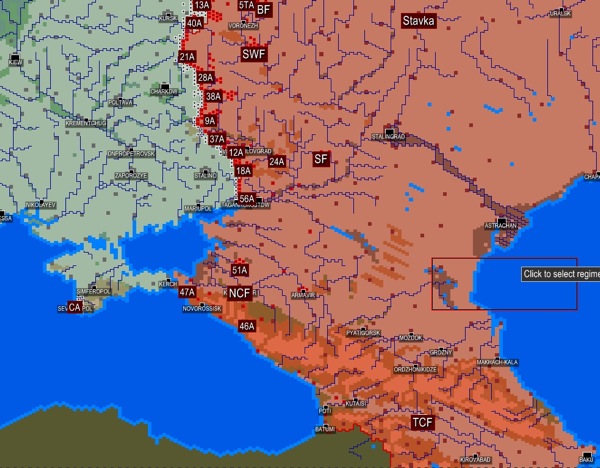
The storm breaks!
The initial German onslaught seems to focus on the roads towards Voronezh and the center (Valyuki-Kupyansk area). The south is quiet and the Germans seem to be re-ordering some panzer divisions around there.
I decide to retreat my 13A and 40A behind the Don at Voronezh and hold the line there. I plan to try a fighting retreat in the center and to hold my ground at the front near Voroshilovgrad and Rostov.
Events till 6th of July

All goes according to plan …
The Germans have taken Sevastopol by storm. I have managed to evacuate about 2–3 divisions with the Black Sea Fleet, however. The front held sort of well at Vorshilovgrad and Rostov. The terrain is good for defense here. Although I allowed the Germans to advance a little, in the hope of them running out of supplies while trying to advance east. I pooled most tanks and mechanized formations in this "donbas" area under command of 28th Army (behind the lines) to prepare a counterstroke.
The retreat behind the Don at Voronezh went well; the enemy took up positions on the other side and we no await their assault.
In the center the fighting retreat did delay the fascist invader but at too high a cost. In retrospect it was foolish not to retreat quicker here and hubris not to wait for more reinforcements before making a stand.
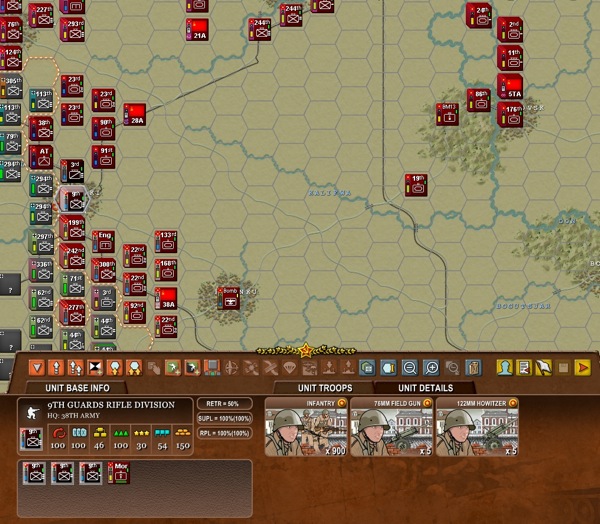
In this screenshot you can see the 9th Guards Rifle Division already dangerously low on manpower defending Valyuki. In the east you can see 5th Tank Army massing behind the lines for a counteroffensive.
Events till 16th of July
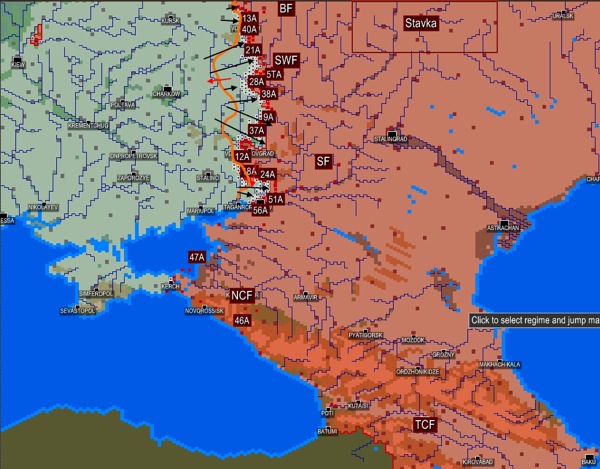
Soviet counterattacks
Mixed news. The good news is the line on the Don near Voronezh held very well. The Germans managed to take some bridgeheads at heavy cost, but those will be repulsed in the next rounds by my reserve Soviet Tank Corps, that was held back until now for exactly this reason.
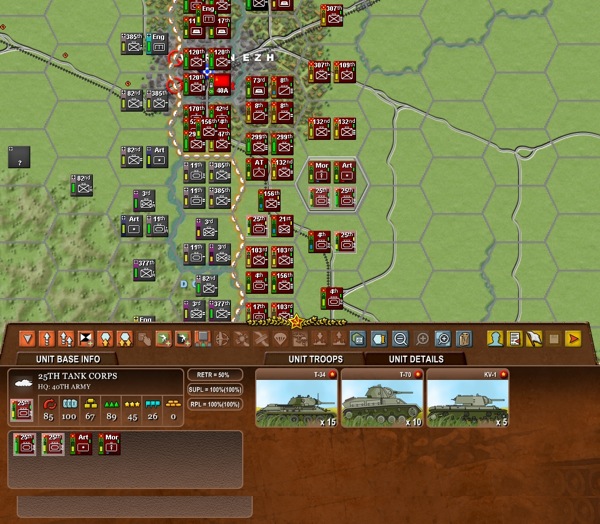
25th tank corps standing ready to drive the fascists back over the Don
In the center 5th Tank Army counter-attacked in the center around the 8th of July, but this was a big disaster. Somehow I managed to attack where the Germans were strongest and I made no ground. Subsequent German counterattacks sent my 5th Tank Army reeling. It was around this time I called off this tank drive and belatedly tried to make a retreat to the Don in the center. It felt like the Germans hardly noticed I was trying to make a major counterstroke here. It’s really a bit of a sad story. And the retreat … it was already too late as you can see in the following screenshot.

5th Tank corps retreated from its failed offensive, remnants of 21A, 38A and 9A follow.
In the south after trying to distract the Germans with a surprise (and expensive) amphibious operation near Taganrog, I counterattacked with the reinforced 28th Army. This attack gave some initial surprise but eventually I did not have the forces available to it to keep going forward after German reinforcements arrived. The massing of AA units and fighter units was however effective in keeping my own tanks intact and keeping the Luftwaffe at bay. It’s nice to see some local air superiority at this stage of the war is possible.
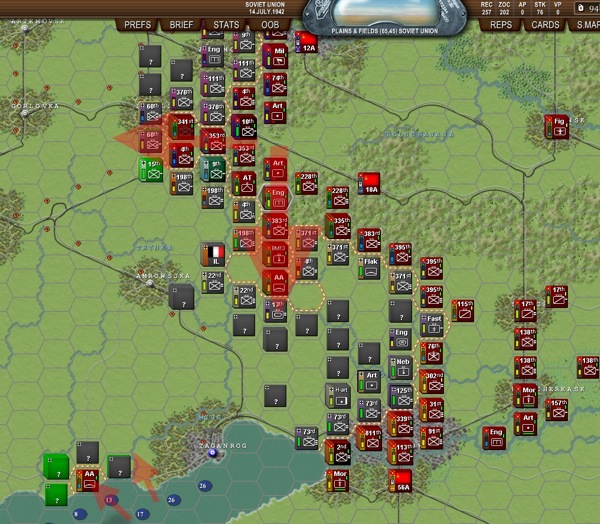
Soviet 28th Army counter attacks the weak German flanks
Last but not least, a really small group (size of six brigades) of infantry forces managed to retake Kerch by an ingenious amphibious operation. First stage of the operation was landing troops further west and threatening to cut Kerch off and lure troops away from the Kerch garrison. This worked like a charm. Second stage was the actual landing of the core troops directly around Kerch and surrounding it. Together with the sea blockade and heavy shore bombardments by the Red Navy the weak defensive forces left in Kerch were overtaken the next round.
Events till 26th of July

The center is shattering
By the 26th of July it is painfully clear my armies in the center are no longer in any state to fight. A head-long retreat had begun some rounds ago towards the Don and it had not done these troops any good: they are now mixed up, low on readiness, low on integrity and often missing parts of their divisions. This miserable state of my forces prevented me from defending the Don properly and I could not repeat what I did at Voronezh. Germans quickly crushed or bypassed the few defending units I had left. Even worse, the collapse of the center and the failure to defend the Don line south of Voronezh is now starting to threaten the successful holding of the Voronezh line itself.

How the Germans see things: 9th Panzer crossed the Don and is about to drive up north to encircle the Soviet armies around Voronezh.
About this time, I am sending all reinforcements available to the center in an attempt to form a coherent defense there again. Nice, but late—the disintegration of the center was already causing spillover problems, for the earlier mentioned Voronezh line, but also for the armies that had been so successfully holding out and counterattacking around Vorshilovgrad. 9A and 37A have been so weakened they are collapsing against strong German attacks. Voroshilovgrad Army, 12A and 24A are now getting in serious danger of encirclement. Alas, I realized this a few rounds too late.

Voroshilovgrad was holding, but 37A and 9A towards the north are being run over by a storm of steel.
Events till the 5th of August
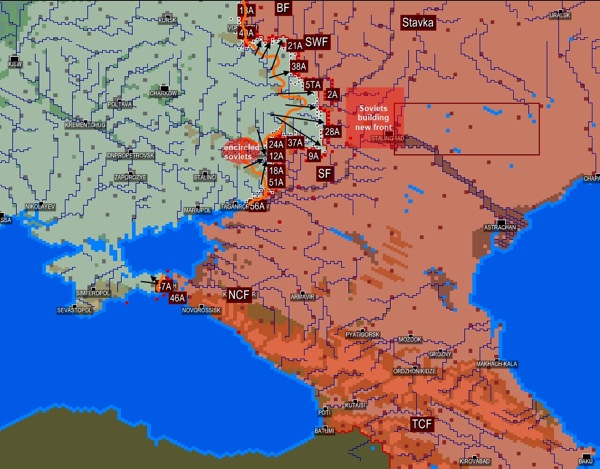
Dawn of disaster
And my worst fears became real. I lost the best part of three armies in pockets and in hopeless escape and relief attempts.
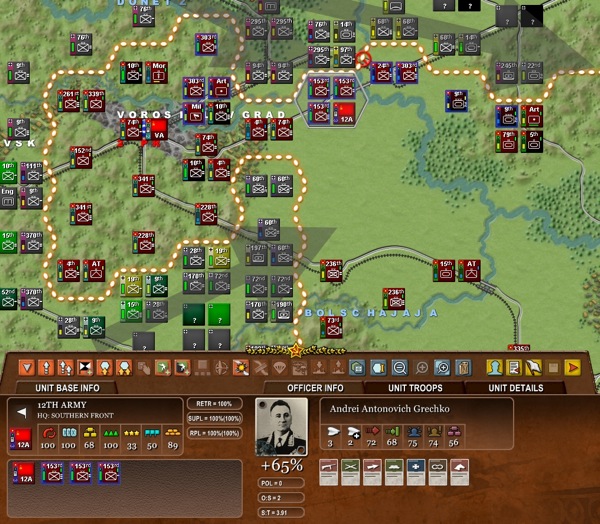
28th of July, the pocket near Vorshilovgrad is almost created; German pincers are about to close.
Meanwhile at the beginning of August it becomes clear Voronezh needs to be evacuated to avoid the same fate as the forces around Vorshilovgrad.
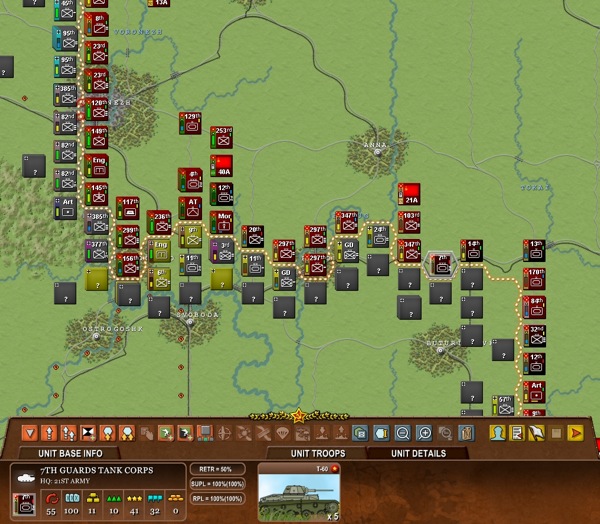
The 21st army south-east of Voronezh can no longer keep the front together.
At least in the center the pressure seems to drop a little as German panzers seem intent on driving south instead of farther east. 28th army has gotten a lot of reinforcements and 2nd Army has been newly created. The forming of these two armies has, however, been denying reinforcements and replacement troops to the other parts of the front. And it’s a subtle process, but after a few weeks I think the other fronts can tell.
Events till 15th of August

And the impossible happened! The remaining forces escaping the pocket around Vorshilovgrad and the still-fighting remainders of 37A (and partly 9A) get caught in another huge pocket. I misjudged the speed with which the panzers were turning south and the effect their cutting of my supply lines would have on my troops in this area.

We can see remnants of 5 armies here. Only 9th Army will escape complete destruction.
In the north, two retreating armies from Voronezh are almost cut off. One blown bridge here held up the evacuation for six days, almost allowing German panzers to pocket them. It’s amazing to see what an effect one crucial bridge being destroyed by the Luftwaffe can have. Mud, emergency fortifications and reinforcements prevented the closing of the pocket, however, and postponed the fate of 13A and 40A.
The only good news is the center, where by 15th of August three armies are lined up and are sort of keeping the line: 2A, 28A and 9A.
Events till 23th of August
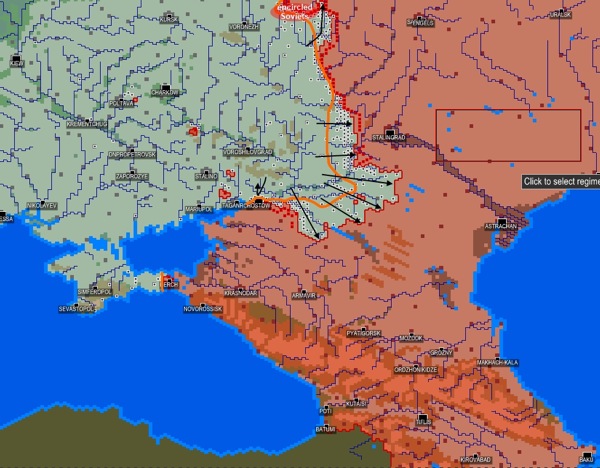
Red defeat imminent
At the 23th of August the Soviets are barely holding on to Rostov. If the scenario would not stop after August 29th I might have evacuated Rostov already at this time.Even though a week earlier I thought my Voronezh armies would escape encirclement they got encircled after all in an even larger pincer movement.
In the center the front is fragile and slowly giving way; my troops await more replacements and reinforcement units before taking a stand.
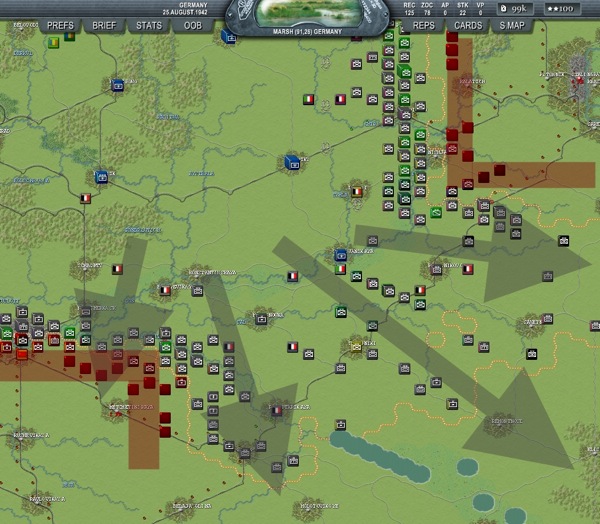
The German perspective as their motorized units fan out into the steppe. Notice that Rostov in the far left is still holding out.
Events till the 29th of August [end of scenario]
In the last rounds the weather really turned against the fascist invaders. Lots of mud! They struggled hard and made some bloody and foolish direct assaults in the inner city of Rostov but did not manage to take the town. The Germans finally managed to occupy 360 VP locations and managed to get a 70 VP bonus due to the enormous loss of Soviet manpower. The total 430 VP made the game result in a (minor) German victory. Germans would have needed to take Rostov or Stalingrad as well for a major victory. They were pretty close.
![]() Conclusions
Conclusions
Still. let’s be honest … I lost the game. I made a huge mistake as the Soviet player. I should have retreated in the center from the start. The Soviets really need the 200K reinforcement and replacement troops they’ll receive over the month of July to have a chance of holding the Don line.
My counteroffensives were, in retrospect, a bit of a waste, I should have combined my 5TA and my reinforced 28A to strike in one spot, and I should have held off doing that until the Germans actually showed a real weakness somewhere.
I think in the end I must have lost over 300k troops in pockets near Voronezh and north of Rostov—pockets that could have been avoided if I had been less stubborn.
I had a good experience with holding Vorshilovgrad and Rostov. I think this is a very defensible area that should not be abandoned too quickly by the Soviet player. Furthermore, I had very positive results with manning a big river line (the Don at Voronezh) and keeping mobile mechanized forces in reserve for counterattacking any successful enemy crossings.
I enjoyed this game a lot and feel a bit bad I have left the Red Army in such a mangled and horrendous state. I lost almost three-quarters of a million men in two months time. This also weighted heavily on the final VP score for Germany. Next time I’ll be more prudent and wait till Stalin actually orders me to hold all ground before I actually try to do so.
![]() Post Scriptum – The German perspective
Post Scriptum – The German perspective
This AAR has been written from the Soviet perspective. I asked my opponent, Jacco van Weert, for his perspective. This is how he and the Germans experienced the battles:
The original plan was to transfer most of the mobile forces to the center and to execute a kind of "von Schlieffen Plan," except I would be driving to the east and Rostov instead of toward Paris. So, 4th Panzer Armee would cross the Don and drive to Stalingrad; 1st Panzer Armee (enforced with parts of 4th PA) would drive through good "Panzer grounds" between the Don and Millerovo, turn south to cross the Don, and then split into two parts, one going south to Rostov and one heading south to Stalingrad.
The first turns felt like running from river to river, with the enemy pulling back when a battle was about to start. Therefore, the Soviets were able to build a strong defense around Voronesh. The timetable for 4th Panzer Armee was gone, as they were busy with time-consuming battles to cross the Don and attack Voronesh from the rear.
The front in the south: 17th Armee at Stalino was secondary; that attack was intended to draw forces to that part of the front. Although the attack of the 28th Army was causing some panic, after studying the situation, the conclusion was drawn that those forces weren’t strong enough. On the negative side, for some reason I couldn’t succeed in trying to take Rostov by storm. All the "Krim" artillery was assembled and Rostov was becoming the smaller Stalingrad. Every turn I just tried it again, and very slowly I took block by block, but it was a mistake. I just should have waited for the encirclement. I was completely surprised by the amphibious operation at Kerch.
Luckily, 1st Panzer Armee was the star of the show. While III Panzer Korps attacked at Millerovo to draw more enemies into that area, LVI and XXXXVI Panzer Korps were turning south and storming the Don. After III PanzerKorps was transferred to the west flank, the encirclement was completed.
The turns thereafter felt like it would be a walk in the park, but then came the mud, and the supply problems. 4th PA achieved a great victory in the Voronesh area, but at same time it should have been the northern arm of the Stalingrad attack.
In conclusion, I won because I managed to encircle more men than happened historically but I didn’t achieve the objectives in time. Would Stalingrad have been an easier target with all those men gone?


Nice. But why the very bad quality screenshots? It seems i went back 10 years.
Wow, great AAR. It seems like things were really interesting when it ended. I wish you’d put up an AAR of the full Case Blue.